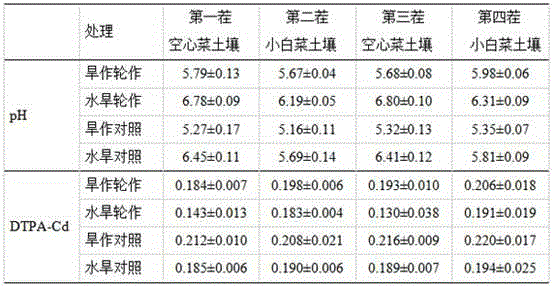Crop rotation method capable of reducing content of cadmium in leaf vegetables
A technology for cadmium content and vegetable cadmium, which is applied in the field of crop rotation to reduce the cadmium content of leafy vegetables, can solve the problems of affecting the yield of agricultural products, affecting the economic benefits, and being difficult to popularize and apply.
- Summary
- Abstract
- Description
- Claims
- Application Information
AI Technical Summary
Problems solved by technology
Method used
Image
Examples
Embodiment 1
[0017] A pot experiment was carried out in a vegetable field soil with Cd exceeding the standard, the soil pH was 5.47, and the total Cd content was 0.450 mg·kg -1 , the content of DTPA-Cd is 0.257 mg·kg -1 . The crop rotation mode in the experiment was water spinach-bak choy-water spinach-bak choy, pak choy was dry-fed, and water spinach was submerged and dry-grown during the whole growth period. -3cm water layer, during the growth period of water spinach during dry farming treatment, the soil moisture is controlled at about 75% of the saturated water holding capacity. No leafy vegetables were used as the control for the paddy and dry crop rotation and dry crop rotation respectively. There were 4 treatments in total, and each treatment was repeated 5 times. The water spinach is topdressed twice during the whole growth period, and the special fertilizer for vegetables (15-4-8) is applied. The cabbage is topdressed once during the whole growth period, and the special fertil...
Embodiment 2
[0027] A pot experiment was carried out in a vegetable field with Cd exceeding the standard, the soil pH was 5.75, and the total Cd content was 0.653 mg·kg -1 , the content of DTPA-Cd is 0.351 mg·kg -1 . The experimental crop rotation mode is watercress-choy sum-watercress-choy sum. The watercress adopts the dry farming method, and the watercress adopts two modes of flooding and dry farming during the whole growth period. There is a 2-5cm water layer on the surface, and the soil surface should be kept moist during dry farming. A total of 2 treatments, each repeated 4 times. Watercress was topdressed 3 times during the whole growth period, and Chinese cabbage was topdressed 2 times during the whole growth period, and the fertilization of each treatment was consistent. From each stubble to the harvest period, the aboveground parts of leafy vegetables were harvested, and their fresh weight and Cd content were measured; soil samples were collected to measure soil pH and DTPA-Cd...
Embodiment 3
[0035] The experiment was carried out in the vegetable field soil with Cd exceeding the standard, the soil pH was 6.01, and the total Cd content was 0.533 mg·kg -1 , the content of DTPA-Cd is 0.225 mg·kg -1. The crop rotation mode of the test is water celery-choy sum-water spinach-mustard green. The water celery and water spinach adopt dry farming mode. There is a 3-6cm water layer on the surface, and the soil surface should be kept moist during dry farming. A total of 2 treatments, each repeated 3 times. Water celery was topdressed 3 times during the whole growth period, water spinach was topdressed twice during the whole growth period, Chinese cabbage and mustard greens were topdressed once during the whole growth period, and the special fertilizer for vegetables was applied, and the amount of fertilizer applied in each plot was the same. From each stubble to the harvest period, the aboveground parts of leafy vegetables were harvested, and their fresh weight and Cd conten...
PUM
 Login to View More
Login to View More Abstract
Description
Claims
Application Information
 Login to View More
Login to View More - R&D
- Intellectual Property
- Life Sciences
- Materials
- Tech Scout
- Unparalleled Data Quality
- Higher Quality Content
- 60% Fewer Hallucinations
Browse by: Latest US Patents, China's latest patents, Technical Efficacy Thesaurus, Application Domain, Technology Topic, Popular Technical Reports.
© 2025 PatSnap. All rights reserved.Legal|Privacy policy|Modern Slavery Act Transparency Statement|Sitemap|About US| Contact US: help@patsnap.com



